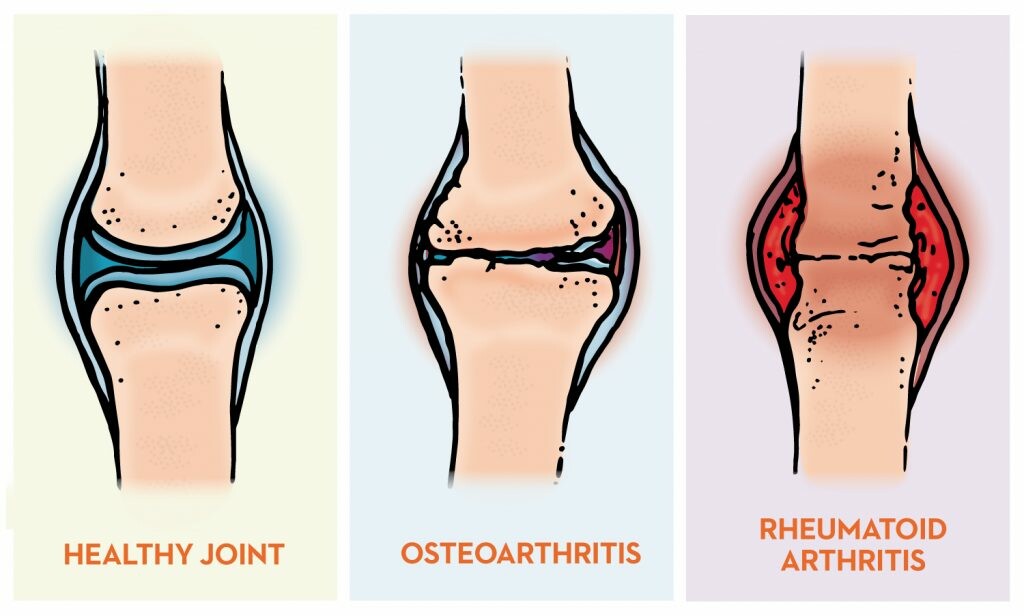
As you age, your joints can become stiff and painful—a condition known as arthritis. Though there are several types of arthritis, they all share the same symptoms. To properly diagnose and treat the condition, it is important to understand what blood tests reveal about arthritis.
Types of Tests for Arthritis
The type of test used to diagnose arthritis will depend on the type of arthritis being tested for. A complete blood count (CBC) measures components in the blood that can indicate whether inflammation is present in your body. This test is used as an initial screening tool for rheumatoid arthritis (RA). It can also be used to measure how well a treatment plan is working by looking at changes in levels over time.
Another common test for RA is the C-reactive protein (CRP) test, which measures the amount of protein produced in response to inflammation. If a CBC shows signs of inflammation but does not provide enough information, then a CRP test may be ordered to confirm or rule out an RA diagnosis. In cases where RA is suspected but has not been confirmed, both tests may be ordered together to get a more comprehensive overview of a person’s health status.
People with osteoarthritis (OA) typically do not require any specific tests beyond a physical examination and imaging studies such as X-rays or MRI scans. However, if OA symptoms are severe or persistent, doctors may order blood tests such as an ANA panel or a rheumatoid factor (RF) assay to rule out other forms of inflammatory arthritis including RA and psoriatic arthritis (PsA). An ANA panel looks for antibodies in the blood that could indicate autoimmune disease while an RF assay measures the level of autoantibodies present in the body—high levels could indicate RA or other forms of inflammatory arthritis such as PsA.
Blood testing plays an important role in diagnosing and managing many types of arthritis including rheumatoid and psoriatic arthrits. For women over 40 who are experiencing joint pain and stiffness, it’s important to talk to your doctor about potential causes and any recommended tests that may help inform their diagnosis. With proper screening tools like CBCs and CRPs, you can gain insight into what might be causing your joint pain so that you can get on track toward feeling better soon!
Here is the link to what I use to manage my inflammation.
Get my free guide "3 ways to reduce inflammation" !
Ask me about the 11 day jumpstart to reduce pain and inflammation
Disclaimer: The information in this article is for educational purposes only and should not be considered medical advice. Please consult with a healthcare professional before making any changes to your diet or lifestyle.

If you're over the age of 40, you may have heard about arthritis and how it can make your life challenging. But did you know that taking Vitamin B-12 can help reduce the symptoms of arthritis? In this blog post, we'll take a look at why Vitamin B-12 is recommended for managing arthritis and how it can benefit you in the long run.
What Is Arthritis?
Arthritis is a group of conditions that cause pain, swelling, and stiffness in the joints. It's one of the most common causes of disability in adults over 65 years old. The two main types are osteoarthritis and rheumatoid arthritis. Osteoarthritis occurs when there is wear and tear on the cartilage that cushions the joints. Rheumatoid arthritis occurs when the body's immune system mistakenly attacks healthy tissue in the joints causing inflammation.
How Can Vitamin B-12 Help with Arthritis?
Vitamin B-12 has been found to be beneficial for people suffering from both types of arthritis. Studies have shown that supplementing with vitamin B-12 can help reduce inflammation and joint pain caused by arthritis. Additionally, vitamin B-12 helps improve energy levels in people who suffer from fatigue due to their condition. Finally, vitamin B-12 also helps support bone health which may help prevent further joint damage caused by osteoarthritis or rheumatoid arthritis.
Where Can I Get Vitamin B-12?
Vitamin B-12 can be found naturally in foods such as fish, meat, eggs, dairy products, fortified cereals, and some yeast extracts like Marmite. However, since many people don't get enough from their diets alone, taking a supplement may be necessary to ensure adequate intake of this important vitamin. Supplements usually come in either pill or liquid form and should be taken under a doctor's supervision if you have any existing medical conditions or allergies to certain ingredients.
All in all, adding Vitamin B-12 to your diet can help relieve some of the symptoms associated with both osteoarthritis and rheumatoid arthritis as well as improve energy levels overall. While vitamin supplements should never replace traditional treatments prescribed by your doctor, they can be an effective way to manage symptoms while also providing essential nutrients that may otherwise not be available through diet alone. So if you're looking for an easy addition to your daily routine that could help ease your joint pain due to arthritis - try adding a vitamin b-12 supplement today!
This is my favorite source of B-12
Here is the link to what I use to manage my inflammation.
Get my free guide "3 ways to reduce inflammation" !
Ask me about the 11 day jumpstart to reduce pain and inflammation
Disclaimer: The information in this article is for educational purposes only and should not be considered medical advice. Please consult with a healthcare professional before making any changes to your diet or lifestyle.

Arthritis is a blanket term used to describe joint pain, stiffness, and swelling caused by inflammation in the joints. There are many types of arthritis, each with its own set of symptoms. The two most common types of arthritis are osteoarthritis (OA) and rheumatoid arthritis (RA). Understanding the differences between these two conditions is key to getting an accurate diagnosis and choosing an effective treatment plan.
What is Osteoarthritis?
Osteoarthritis (OA) is the most common form of arthritis in adults over the age of 50. It happens when cartilage, which acts as a cushion between bones in your joints, begins to break down. This can cause friction between bones and cause pain, stiffness, and swelling in your joints. OA can happen in any joint but commonly affects hands, hips, knees, spine, or feet.
What is Rheumatoid Arthritis?
Rheumatoid arthritis (RA) is an autoimmune disorder that causes inflammation throughout your body but mainly affects your joints. Unlike osteoarthritis where only one joint may be affected at a time, RA usually affects multiple joints at once and can cause pain on both sides of your body. RA also has other effects such as fatigue, fevers, dry eyes/mouths, rashes/lumps under skin or nodules on fingers/toes. If left untreated it can cause deformities in the affected joints and even lead to disability.
Arthritis may seem like a daunting condition but understanding the differences between OA and RA can help you get an accurate diagnosis so you can choose a treatment plan that works best for you. While there is no cure for either type of arthritis yet, treatments such as physical therapy, natural supplements or medications may help reduce pain and improve mobility so you can continue living life to its fullest! Talk to your healthcare provider today if you think you may have symptoms of either condition so they can create a personalized treatment plan just for you!
Here is the link to what I use to manage my inflammation.
Get my free guide "3 ways to reduce inflammation" !
Ask me about the 11 day jumpstart to reduce pain and inflammation
Disclaimer: The information in this article is for educational purposes only and should not be considered medical advice. Please consult with a healthcare professional before making any changes to your diet or lifestyle.

Arthritis is a common condition that affects many people, especially women over 50. While it is a chronic condition, there are treatments and lifestyle modifications that can help to manage its effects. One of the most important considerations for arthritis sufferers is understanding how quickly the disease spreads. Let’s take a look at what you need to know about the spread of arthritis.
The Rate of Arthritis Spread Varies
The rate at which arthritis spreads can vary from person to person. There are several factors that can affect the speed with which arthritis spreads, including age, genetics, and existing medical conditions. The severity of your symptoms and how long they last will also be taken into account when determining the rate of spread. Generally speaking, however, it is believed that arthritis tends to progress slowly over time.
Managing Symptoms Can Help Slow Progression
It’s important to note that while there is no cure for arthritis, there are several treatments available that can help manage its symptoms and slow its progression. These treatments include medications such as non-steroidal anti-inflammatory drugs (NSAIDs) or corticosteroids; physical therapy; lifestyle modifications such as exercise and weight loss; and alternative therapies like natural supplements, acupuncture or massage therapy. Additionally, patients should consider utilizing assistive devices such as braces or splints to improve mobility and reduce joint pain or stiffness caused by arthritis.
It’s important for women over 50 who have been diagnosed with arthritis to understand that there are ways to manage their symptoms and slow down the progression of the disease. Even though there is no cure for arthritis, taking steps like addressing underlying causes, making lifestyle modifications, using assistive devices and undergoing physical therapy can all help to minimize pain and discomfort while improving quality of life in general. By understanding how fast arthritis spreads and taking steps to control its progression, you can live a full life despite having this condition!
Here is the link to what I use to manage my inflammation.
Get my free guide "3 ways to reduce inflammation" !
Ask me about the 11 day jumpstart to reduce pain and inflammation
Disclaimer: The information in this article is for educational purposes only and should not be considered medical advice. Please consult with a healthcare professional before making any changes to your diet or lifestyle.

For those living with arthritis, managing the pain can be a full-time job. While there is no cure for arthritis, it’s important to understand that certain foods can make the condition worse. Knowing which foods to avoid and which to embrace is essential for maintaining joint health. Let’s explore what foods can cause your arthritis to flare up.
Processed Foods
Processed foods are filled with trans fats and sugars, both of which can worsen joint pain in people with arthritis. This includes frozen meals, pre-packaged snacks, and foods high in saturated fat (such as fried food). Eating too much processed food can lead to inflammation and other conditions that make arthritis symptoms more severe.
Sugar
We all know that sugar isn’t good for our health, but did you know that it can also worsen your arthritis symptoms? When consumed in great amounts, sugar causes a spike in blood glucose levels—which in turn leads to inflammation throughout the body. So if your goal is to reduce your joint pain and stiffness, cutting back on sweets such as cake and cookies is a must!
Alcoholic Beverages
Alcohol consumption has long been linked to an increase in joint pain for those with arthritis. Alcoholic beverages like beer and wine contain purines—a compound that breaks down into uric acid—which is known to trigger inflammation. It’s best to keep alcoholic beverages at a minimum if you suffer from any form of arthritis.
As you can see, certain foods have been linked to increased arthritic symptoms—and avoiding them may help relieve some of the pain associated with this chronic condition. There are also many other steps you can take when dealing with arthritis; for instance, engaging in regular physical activity (under doctor supervision), practicing stress management techniques such as yoga or meditation, and using natural treatments such as hot or cold compresses or herbal remedies may all help mitigate your symptoms over time. By making changes in your diet and lifestyle today, you are taking an important step towards managing your joint health tomorrow!
Here is the link to what I use to manage my inflammation.
Get my free guide "3 ways to reduce inflammation" !
Disclaimer: The information in this article is for educational purposes only and should not be considered medical advice. Please consult with a healthcare professional before making any changes to your diet or lifestyle.












